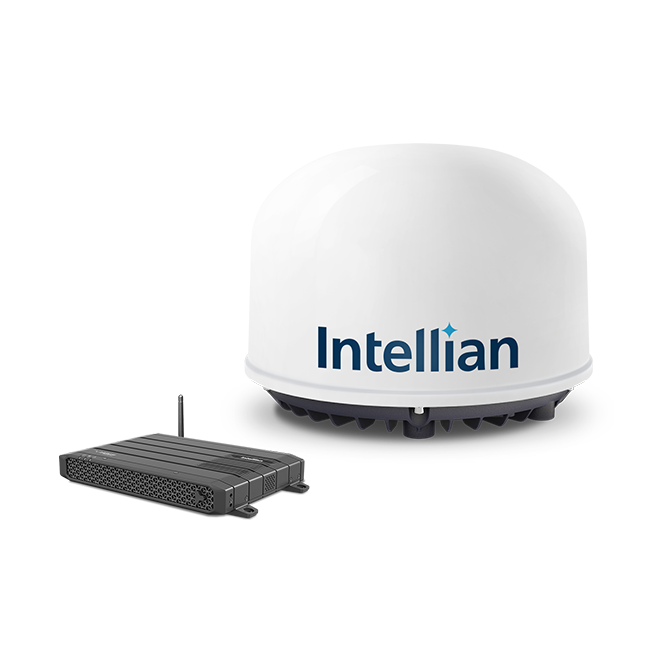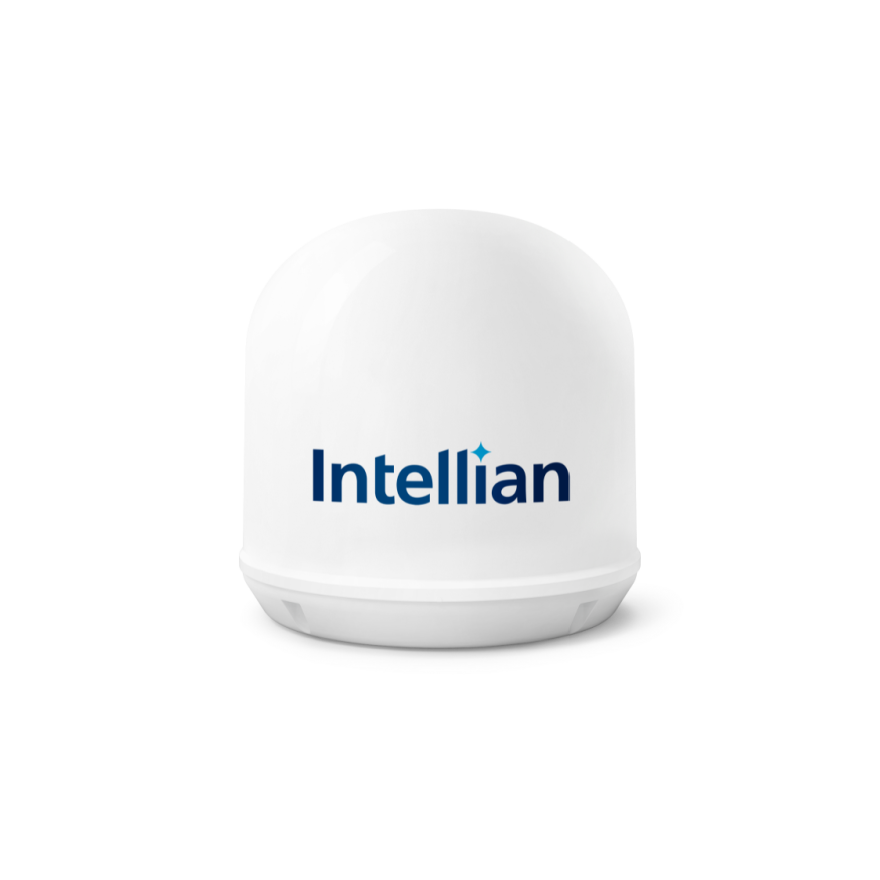
Truly Global Powerful Performance
- Satcom L-Band
- Overview
- L-Band
- Market Sectors
- Product Porfolio
- Where to Buy
- FAQ's
L-band reliable global connectivity
L-band is a satellite frequency providing extremely reliable and resilient communications across the world and has been used for the Global Maritime Distress and Safety System (GMDSS) for many years.
With internet and voice capabilities, it’s the ideal service for primary communication onboard smaller vessels or as a VSAT back-up onboard larger vessels. Intellian’s range of L-band products includes the C700 designed for Iridium’s Certus network and our Intellian Fleet One, FB250 and FB500, for use on Inmarsat’s ELERA network.

Intellian FleetBroadband Terminals
Intellian Fleet One, FB250 and FB500 L-band satellite communication terminals are designed for use on the Inmarsat FleetBroadband network, ELERA. FB250 and FB500 FleetBroadband terminals have been designed to work equally well as part of an FX installation or as fully featured stand-alone terminals. These systems ensure reliable, voice calling and internet connectivity. In addition, they ensure distress signals get through to an MRCC (Maritime Rescue Coordination Center), as a GMDSS (Global Maritime Distress and Safety Service) solution for non-SOLAS vessels.

Intellian C700 Certus® Terminal
Stay connected with the most powerful Iridium Certus terminal available. The Intellian C700 maritime satellite terminal utilizes the Iridium Certus network of 66 Low-Earth Orbit (LEO) satellites, providing pole-to-pole communication. With its best-in-class RF performance, the C700 can deliver out-of-the-box uplink speeds of 352Kbps and downlink speeds of 704Kbps, with equally impressive low-elevation-angle RF efficiency thanks to its unique 12-patch phased array antenna design. It will support three high-quality, low-latency phone lines simultaneously; and as a solid-state antenna with no moving parts inside, the C700 is especially robust, requiring no scheduled maintenance over its lifetime.
Intellian L-band solutions for maritime users
The L-band Maritime Terminal has been developed to suit all customer demands in the Maritime industry where vessel sizes and communication needs are varied.
Explore our Markets
 |
 |
 |
 |

Where to Buy
Find an Authorized Intellian Reseller
Regardless of your vessel size, company size or industry – our partners can help you buy, build, implement, service, support and run the Intellian total solution that best fits your unique needs. Find a trusted professional to work with today.
What is an L-band maritime satellite antenna and what is it used for?
An L-band maritime antenna is a type of antenna used for communication in the maritime industry. L-band refers to a range of frequencies between 1 and 2 GHz, which is commonly used for satellite communication in maritime applications.
L-band maritime antennas are designed to receive and transmit signals from L-band satellite systems, which are used for various applications such as weather tracking, navigation, and communication with shore-based facilities. These antennas are typically compact, lightweight, and durable to withstand harsh marine environments.
L-band maritime antennas can be used for both voice and data communication, including internet connectivity, email, and other digital services. They can be mounted on vessels of various sizes, including ships, yachts, and fishing boats. L-band antennas are widely used in the maritime industry due to their reliability, global coverage, and ease of use.
Why is L-band associated with safety systems?
L-band is often associated with safety systems such as critical aircraft communications and the Global Maritime Distress & Safety System due to its reliability, as it is not affected by meteorological conditions.
What is the speed of L-band terminals and what applications are they suitable for?
The speed of L-band terminals is measured in kbps, which is slower than the Mbps speed of VSAT and home broadband. Therefore, even the fastest L-band terminals are not suitable for applications requiring higher data speeds such as streaming HD video.
How is L-band used as a backup communication system?
L-band is often used as a backup to a faster primary communication system, such as VSAT or LTE network. For example, Inmarsat’s Fleet Xpress is a service that combines the high data speeds of the award-winning Global Xpress Ka-band network with the proven reliability of the L-band network, ELERA, to offer unrivalled speed, continuous connectivity, and guaranteed performance for true global mobility. Intellian’s L-band terminals the FB250 and FB500 have been engineered to perfectly complement our highly successful GXNX series of Ka-band terminals, creating the most innovative FX product offering on the market.
Who uses L-band antennas?
L-band terminals are compact, rugged, and relatively inexpensive, making them popular with the military to provide soldiers with voice communication and with organizations to provide their staff with communication when they are outside the range of LTE networks. L-band is also popular with the maritime industry, often used on smaller yachts and workboats as either a standalone solution or as a VSAT back up service.
What services would I use an L-Band antenna for on my boat?
Voice calls, updating weather charts, emails - and with a faster terminal, such as the Intellian C700 or FB500 you can scroll and post on social media and join SD video calls.
What are the benefits of using L-band for communication?
L-band is very reliable and not affected by meteorological conditions, making it a reliable choice for safety systems. L-band terminals are also relatively inexpensive and can be used as a backup to faster primary communication systems.
Can I use an L-Band antenna as a back-up for my VSAT?
The L-band frequency is highly dependable because it remains unaffected by weather conditions. Due to this characteristic, it has gained popularity as a secondary option to faster primary communication systems such as VSAT or LTE networks. Inmarsat's Fleet Express service is an example which combines VSAT and L-band services for maritime vessels. Moreover, the L-band terminal can serve as a means of remote access, allowing support teams to diagnose and fix any issues with the primary terminal if required.
What are the typical speeds / data rates can I get from an L-Band antenna?
Typical speeds that can be achieved from L-band terminals range from 20 kpbs for legacy terminals to 700 kpbs using Italian’s C700 Maritime terminal.
Which satellite networks do L-Band antennas work on?
L-band terminals are typically designed for a single network operator such as Iridium Certus or Inmarsat’s Elera network. L-band works equally well on LEO and GEO networks
How do L-band antennas work?
An L-band satellite communications antenna functions by transmitting and receiving radio signals in the L-band frequency range, typically 1-2 GHz. Satellite communication uses radio waves at a higher frequency than terrestrial radio, which gives them a greater range, making them useful for communication over long distances, including remote areas or at sea. The communication is two-way, with both the satellite and the terminal sending and receiving data.
The L-band antenna captures the radio signals from the satellite in space and converts them into electrical signals. Similarly, when the communication device sends a signal, it is transmitted to the antenna and converted into radio waves by a feedhorn. The parabolic reflector then sends these radio waves out into space to be received by the satellite.
The terminal has to be in line of sight to the satellite, and the antenna may need to be dynamically pointed at the satellite, depending on the type of antenna and whether the terminal is fixed. In some cases, the satellite will relay the data directly to the ground station, while in other cases, the data may be passed between satellites before being relayed to the ground station.
Once the data is received at the ground station, it is connected to the terrestrial communications network, allowing for further transmission and processing of the data. Overall, L-band satellite communications antennas play a crucial role in facilitating communication over long distances and in remote areas, making them essential for many industries and applications.
How do you make phone calls at sea?
Making phone calls at sea is very similar to making calls on land - you simply dial the number. Network operators assign satellite terminals with one or more dedicated phone number(s) that can be used to call the terminal directly. As satellite phone calls can be quite expensive some user will make calls using apps such as WhatsApp.
What is GMDSS?
GMDSS stands for "Global Maritime Distress and Safety System." It is an international communications system used by ships and coastguard stations for emergency and safety communications at sea. GMDSS uses a combination of satellite and terrestrial communications systems, including VHF, MF, HF, and satellite communication systems, to provide a reliable and efficient means of communication in emergency situations. The system includes a range of safety features, such as distress alerting, search and rescue coordination, and weather forecasts.
The purpose of GMDSS is to enhance safety and security at sea, minimize the risk of loss of life, and ensure that vessels can quickly and effectively communicate distress signals and receive assistance in emergency situations. GMDSS has been instrumental in saving many lives at sea, and it continues to be an essential component of modern maritime communication and navigation systems.
Currently only radio equipment and Inmarsat C-band terminals are approved to provide Global Maritime Distress and Safety Services. However, both Inmarsat and Iridium will be launching L-band GMDSS services in 2023, and these are expected to replace the current C-band service.
What handset can I use with an L-band terminal?
Intellian L-band terminals support both analogue phones and VoIP phones. the following VoIP Phones are recommended:
• Grandstream GXP16 Series: 1610, 1615, 1620, 1625, 1628, 1630
• Grandstream GXP17 Series: 1760, 1780
• Grandstream GXP21 Series: 2120, 2130, 2135, 2140, 2160, 2170
• Grandstream GXV32 Series: 3240, 3275
What are the benefits of L-band?
Very reliable, compact, rugged and relatively inexpensive.
How to minimise airtime cost
One attractive feature of Intellian L-band terminals (except Fleet One) is that they have SD-WAN ports. Many vessel operators connect LTE modems to this SD-WAN port and configure the terminal so that data comms are automatically routed through the LTE modem when the vessel is close to shore and has an LTE modem connection and through the satellite link when an LTE connection is not available. Intellian's terminal management can also be used to set quality of service limits for connected devices - restricting access to voice calling, limiting speed of data connection and setting data consumption limits
What is the SD-WAN port in Intellian L-band terminals?
The SD-WAN port is a feature in Intellian L-band terminals (excluding Fleet One) that allows vessel operators to connect LTE modems to the terminal. This allows data communications to be automatically routed through the LTE modem when the vessel is close to shore and has an LTE modem connection. When an LTE connection is not available, the data is routed through the satellite link.
Can the SD-WAN port be used to manage connected devices?
Yes, Intellian's terminal management system can be used to set quality of service limits for connected devices. This allows vessel operators to restrict access to voice calling, limit the speed of the data connection, and set data consumption limits.
What are the benefits of using the SD-WAN port in Intellian L-band terminals?
The SD-WAN port provides greater flexibility and cost savings for vessel operators by allowing them to take advantage of faster and cheaper LTE connections when available, and seamlessly switch to satellite communications when necessary. The ability to manage connected devices through the terminal management system also allows for more efficient use of data and ensures that data usage is closely monitored and controlled.
How much power does an L-band terminal consume?
This depends on the design of the terminal but typically power consumption is between 20-120W
Do L-band terminals require specialist installers?
Most L-band terminals are straight forward to install and configure. Intellian terminals come with a powerful yet intuitive terminal management software that is used to configure the terminal and set quality of service limits for connected devices.
While it is possible for experienced technicians to install Intellian antennas, it is generally recommended to use a certified Intellian installer to ensure that the installation is done correctly and in compliance with all relevant regulations and safety standards.
Certified Intellian installers have received specialized training and have access to the necessary equipment and tools to properly install and configure Intellian antennas. They are also familiar with the latest product updates and can provide ongoing support and maintenance for the equipment.
Using a certified Intellian installer can also help ensure that the installation is covered under the manufacturer's warranty, providing additional peace of mind for vessel operators. It is therefore highly recommended to work with a certified installer to ensure that the Intellian antenna is installed safely and correctly.



